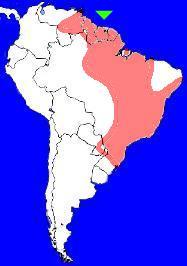 Violaceous Euphonia (Euphonia violacea)
Violaceous Euphonia (Euphonia violacea)
 Violaceous Euphonia (Euphonia violacea)
Violaceous Euphonia (Euphonia violacea) |
 |
| Violaceous Euphonia: The male is beautifully colored: upper side blue-black with yellow underparts and a yellow forehead. The female is inconspiciously colored green. This euphonia lives high in trees, in plantations and for instance in Lelydorp and (not so often) the Cultuurtuin. It can sing for minutes, a sweet high pitched song. Other birds are easily imitated like the house wren and thrushes. It likes small fruit, as from the half parasites that live on branches of trees (fowroedoti, Phoradendron piperoides). The nest is a ball of dead leaves, roots and mosses with a side entrance. The female lays three or four eggs and broods alone. The male helps feeding the young. The violaceous euphonia is kept as a cage bird, but not like the early days of this century when it was maybe the most popular cage bird. Young birds with their spotted appearance and adult males were caught with glue and traps. On the market place they were sold for half a guilder, but even then the large-billed seedfinch [twatwa, Oryzoborus crassirostris] was more costly, up to five guilders (all this I've read in the book of the Penard brothers, a book with much more information on cagebirds and other birds from 1910, printed in Paramaribo). Picture of a male of the Violaceous Euphonia bringing nesting material to its nest, seen by Foek Chin Joe at Charlesburg, Suriname in July 2006. And a male seen by Dennis Binda in August 2008 in Suriname. Next two pictures by Jan Hein Ribot from Lelydorp in February 2014 in a Croton and three by Erik Toorman of a pair with young at the Anton de Kom campus in March 2013. The plant is a orchid (Epidendrum stenopetalum, determined by Pieter Teunissen). On the same picture a plant with the name Pikin Fowru-sopo (little birds soap, Peperomia rotudifolia)can be seen. Jan Hein Ribot saw a Violaceous Euphonia eat from a bospapaya (Cecropia) and from the berries of a Ficus at Overbridge in October. Dominiek Plouvier made the video of a female Violaceous Euphonie eating from a Areca Palm (Dypsis lutescens), a garden tree in Suriname. |
 |
| Video (click the link or the 'play'-button to see) | ||
|---|---|---|
| Video recording of a Violaceous Euphonia © ; |
|
|
||||||||||||||||||||||||||||||||||||||||||||
| Observations through the year | Observations of breeding through the year |
|---|---|
| The 573 reported observations of this bird in Suriname, mainly for the last 50 years up to 2018, have been grouped by month. More birds on one day are counted as one observation. Of course, if the graph should depict the total number of birds seen, the differences between the months could be much more pronounced. | The 18 reported breeding observations of this bird in Suriname. Most observations are about nest with eggs, some about fledglings, or feeding at a nest or the building of a nest. Of the about 5000 nests and eggs found for all species together, about 1/3 comes from the egg collection of Penard between 1896 and 1905. For some reason most collecting then was done in the first half of each year, so the shown distribution does not necessarily reflect the actual breeding preferences. The main dry season in Suriname is reckoned to be from half August to the end of November, the main wet season from half April to half August, but the the timing of begin and end does vary from year to year. Around March a second dry season often occurs. |